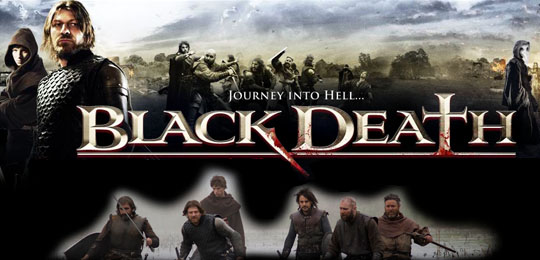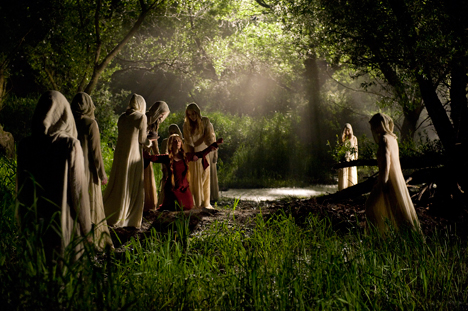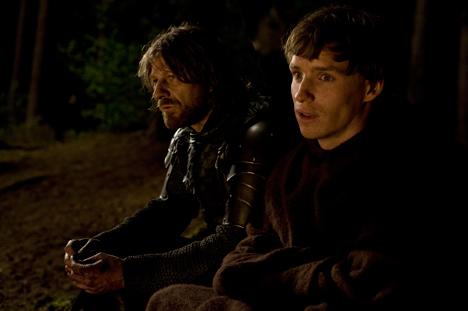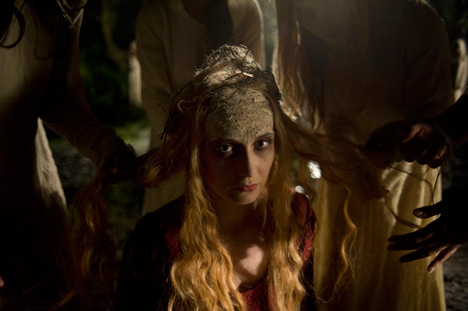Black Death – film review
 In Black Death, screened this year at Toronto After Dark, Sean Bean plays a grizzled dark ages knight who leads a small band of Agincourt veterans, torturers and murderers, plus one world shy monk, on a mission to a investigate claims of a small village that is free from the plague, because a necromancer has been using Satanic power to keep the sickness at bay.
In Black Death, screened this year at Toronto After Dark, Sean Bean plays a grizzled dark ages knight who leads a small band of Agincourt veterans, torturers and murderers, plus one world shy monk, on a mission to a investigate claims of a small village that is free from the plague, because a necromancer has been using Satanic power to keep the sickness at bay.
Now, show of hands; how many of you gave out a little “squeeee!” at the words “Sean Bean” and “grizzled dark ages knight”?
Good. Go see this movie. It’s everything you hope it will be. Everyone who isn’t in the “Sean Bean is the one man I would go gay for club” may read on.
Unsurprisingly, Sean Bean is not actually the star of the show here, though he lends the one big name to an otherwise small production. This isn’t unusual for Bean; he’s a grade A talent who’s made a career out of playing backup, and he’s damn good at it. He has the humility and the skill to walk on stage and immediately point the spotlight at everybody else.
OK, so I’m slightly in the club. Maybe first base.
The real star is Osmund, the world shy monk played with passion and aplomb by Eddie Redmayne. Osmund’s journey is the emotional heart of this piece, as he travels away from the security and simplicity of the monastery, and into a dangerous and brutal world fraught with complexity and suffering.
As the story begins, Osmund is questioning his faith, and beginning to stray from the strictures of monastic life. He is uncertain what his path should be, and wants to stay faithful to God, but doesn’t feel like he really understands the hidebound piety of the other monks. He asks for a sign whether he should leave, and in walks Ulric, the aforementioned grizzled knight, looking for a man who can guide him through the marsh, to the small village he has been charged with investigating. Osmund has his sign.
We meet up with Ulric’s witch hunters, and they set off, in a sequence of road scenes that strongly recall Heart of Darkness, or more specifically Coppola’s Apocalypse Now, with heavy use of the images of mist, water, and savagery set against modernity that perpetuated that film. Even the heavily washed out colour palette is reminiscent of Coppola’s river sequences. This second act serves to introduce and explore the various members of Ulric’s band, allowing us to come to know them all before they arrive at the real scene of the action; the village itself.
And that’s where things get weird. I won’t spoil anything, but the emotional and dramatic interplay that takes place in the village is brilliantly engaging, and segues perfectly into the fourth act, a physically brutal and emotionally uncompromising series of trials, that test each character in turn, pitting their faith against the harsh realities of the world. It’s the classic metaphorical battle between God and the Devil (in this case a literal “lady in red”, played superbly by Carice Van Houten), vying for a man’s soul. Osmund is the pilgrim of our story, trying to walk the narrow path, though everything around him seeks to make him stray. In the end, however, the Devil is unmasked, and God remains absent. There is only the man, left to carry the weight of the things he has done.
Director Christopher Smith, whose previous work (ED note: including Severance, well worth seeking) has been seated firmly in the modern horror genre, adapts well to the period style, and it’s the modern touches he brings with him that really give Black Death a unique feel. The entire film is shot with handhelds, not in the “found footage” style, but in a way that more evokes the feel of a documentary. Its closest equivalent would be the excellent Children of Men, which has much of the same tone.
The film is not nearly so action heavy as the trailer makes out (in fact all of the action shots in the trailer are drawn from just two scenes), but what there is here is executed extremely well. I did feel that the jump cut editing for the fight scenes was a little too rapid, but it was easy enough to follow, and definitely gave that sense of immediacy and brutality that grounds the film firmly in the realities of medieval sword play. I was particularly pleased to see nods to how quickly exhaustion sets in for combatants in chainmail, swinging bastard swords (I’ve tried it, and trust me when I say that it’s not fun).
More than anything, what we have here is a medieval thriller; a mystery movie that hangs on the tension that drips from every word, especially from the point where the protagonists enter the village itself, a sequence that is every bit as eerie and confounding as you would hope. The film constantly toys with the suggestion of supernatural elements, taking the appropriate care to never quite reveal too much, or dispel your illusions too soon. Equally important is the excellent pacing; the story moves at a brisk pace, but without ever losing the darkly miasmic atmosphere, or the sense of slow, creeping horror. It’s that delicate balance between mystery and suspense that is the heart of a good thriller.
 Ultimately Black Death is one of those films where almost everything just works. It doesn’t feel like it’s pushing boundaries, reinventing cinema, or changing your perceptions, but nor does it feel half-finished or insubstantial. In every respect it has the feel of something lovingly crafted. The attention to detail is astounding, both in the presentation of the world, and the design of the film itself. Every element, from the acting, to the screenplay, to the camera-work, the clear and driving focus of the overall aesthetic, contributes to a film that is physically brutal, emotionally uncompromising, and extremely well made in every way.
Ultimately Black Death is one of those films where almost everything just works. It doesn’t feel like it’s pushing boundaries, reinventing cinema, or changing your perceptions, but nor does it feel half-finished or insubstantial. In every respect it has the feel of something lovingly crafted. The attention to detail is astounding, both in the presentation of the world, and the design of the film itself. Every element, from the acting, to the screenplay, to the camera-work, the clear and driving focus of the overall aesthetic, contributes to a film that is physically brutal, emotionally uncompromising, and extremely well made in every way.
The only complaint I had was that it suffered from an ending sequence that went on far beyond the point where the story was done and dusted. The film could have closed a good five or ten minutes before it actually did, and nothing would have been lost. It’s not that these closing sequences are bad, but they add nothing to what has been said, and detract somewhat from the poignance of certain scenes. Indeed, the film has what easily could have been one of the most awesome closing lines ever, if it had not been followed by so much dangling thread. Still, it’s one strike against an otherwise damn fine movie, that is well worth seeing if you have even the remotest interest in the concept of a gritty medieval thriller.
[Official Black Death film site]














Interestingly Eddie Redmayne followed up his role in this movie by playing Jack on the new Canadian TMN series, The Pillars of the Earth, where he also plays a shy monk (part of the time) in medieval England.
Hmmm I hope he doesn’t get typecast as the go-to Hollywood good looking shy monk/priest guy from now on!
[…] Read the rest of this review at the main source! […]